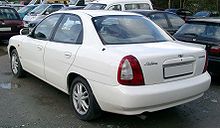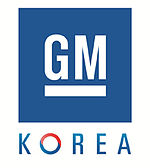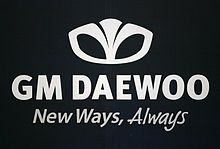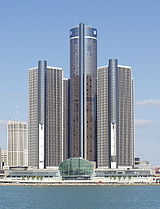- GM Korea
-
See also: Daewoo (disambiguation)
Korean General Motors Corporation Type Subsidiary of GM Industry Automotive Founded 1937 (As Shinjin Industrial Corporation)
2002 (GM Daewoo)
March 2011 (GM Korea)Headquarters Bupyeong-gu, Incheon, South Korea Key people Michael Arcamone, CEO Products Automobiles Employees 17,000 Parent General Motors (82.9%)
Korea Development Bank (17%)
SAIC Group (6%)Website GM-Korea.co.kr Korean General Motors Corporation or GM Korea[1] (former GM Daewoo Auto Technology Company or GM DAT) is South Korea's second largest automobile manufacturer and is a division of the General Motors Company. GM Korea's roots go back to the former Daewoo which was split from its parent company, Daewoo Group, in 2001. It has five manufacturing facilities in South Korea as well as a vehicle assembly facility in Vietnam. In addition, GM Korea provides region and brand-specific vehicle assembly kits for assembly by GM affiliates in China, the United States, Australia, Germany, India, and Brazil. In 2008, GM Korea built more than 1.9 million vehicles, including CKD products. GM Korea now produces vehicles and kits for Chevrolet, Opel and Buick that are offered in more than 150 markets on six continents. On January 20, 2011, General Motors announced that GM Daewoo would be renamed GM Korea "to reflect [Daewoo's] heightened status in [the] global operations of GM,"[2] effective March 2011. Most of the former Daewoo products were rechristened as Chevrolets, with plans for GM to establish either the Cadillac or Buick brands there.
Contents
History
See also: Daewoo MotorGM Korea's roots go back to the remnants of the Korean War and Shinjin Motor, which launched its business by rebuilding scrapped US military vehicles. Shinjin Motor was first established as National Motor in 1937 in Bupyeong-gu, Incheon, South Korea. After changing its name to Saenara Motor in 1962, Saenara Motor was bought by Shinjin Industrial in 1965, which changed its name to Shinjin Motor after establishing a partnership with Toyota. After Toyota's withdrawal in 1972, Shinjin Motor changed its name to GM Korea (GMK) in 1972 with General Motors purchasing a 50% stake in the company from Toyota in 1972; however GMK was renamed again in 1976 to Saehan Motor. Korean Development Bank (KDB), the company's creditor, took over management in 1976 as the company found itself unable to cope with competition from Hyundai and Kia. After the Daewoo Group gained control in 1982, the name was changed once more to Daewoo Motor. In the early 1990s the company started to expand heavily throughout the world. Until 1996 all Daewoo cars were based on GM-designed models. After the Asian financial crisis reached South Korea in 1997, Daewoo took over the troubled SUV manufacturer SsangYong in 1998, but ran into financial trouble and was forced to sell the company off in 2001 to GM affiliate SAIC.
The establishment of GM Korea
In 2001 General Motors bought most of Daewoo Motor's assets to form GM Daewoo. The new company started operations on October 17, 2002, with GM and its partners Suzuki and SAIC holding a stake of 66.7% with investments of US$400 million. The GM holding was formally purchased by GM Holden Ltd which holds a seat on the board and is legally responsible for GM Daewoo.[3] The remaining equity stake of 33.3% was held by Korea Development Bank and several other Korean creditors with investments of US$197 million. The deal did not include 15 plants, including Daewoo's oldest plant in Bupyeong-gu which is now operated under the name Incheon Motor Company as a supplier to GM Daewoo. In 2004, Tata Motors purchased Daewoo Truck from GM. In February 2005, GM invested US$49 million to raise its share in the company to 48.2%. In 2010, General Motors owned 82.9%, SAIC 9.9 %, and the Daewoo Motor Creditors Committee the remaining 7.2%.[4]
GM Korea has design, engineering, research & development facilities that are involved in development for various GM products, above all small-size cars. On November 25, 2003, the design center was relocated to the new 2-story building at the Bupyeong-gu headquarters. The first car to be produced under the GM Daewoo nameplate was the 2002 GM Daewoo Lacetti, replacing the Nubira. This car was developed in South Korea under the Daewoo Motor era, but it gradually became a GM world car, sold under many different marques all around the globe. After a few years without any new cars to present, in 2005, GM Daewoo introduced the Holden based Statesman luxury car replacing the discontinued Daewoo Chairman. The third generation of Matiz was introduced, refreshed by the GM Daewoo design team, and an evolution of the 4-door Kalos appeared: the Gentra.
In early 2006, GM Daewoo presented Tosca, the replacement of the Magnus. GM Daewoo's official press releases says that Tosca is an acronym for "Tomorrow Standard Car". The end of the same year, GM Daewoo introduced the Winstorm - its first proper SUV, which was, as the Lacetti, sold worldwide under different marques and names including Opel, Chevrolet, GMC and Holden, and previously Saturn before the demise of that brand in 2010. It featured a common rail Diesel engine for the first time in a Daewoo vehicle, in addition to regular four and six cylinder gasoline engines. The diesel engine design is licensed from the Italian engine maker VM Motori.
2007 has seen the introduction of the wagon version of the Lacetti and Kalos hatchback's facelift, becoming Gentra X. For 2008, GM Daewoo introduced the first Korean-made roadster: the G2X sports car, a badge-engineered Saturn Sky, and started to sell the Opel Antara under the name of Winstorm MaXX. The Statesman flagship was also replaced by the new Veritas which is now based on the Holden Caprice V.
Late 2008 and early 2009 were a major period for GM Daewoo with the introduction of the all-new Lacetti Premiere, which is based on the Chevrolet Cruze, a very important compact car for GM divisions worldwide. The the newly rechristened third generation of the Matiz was added to the range in 2009 as the Chevrolet Spark.
As of the end of 2011, GM Korea also manufactures the Chevrolet models Malibu and Orlando, as well as the new standalone brand Alpheon.
GM Daewoo cars outside South Korea
Before GM’s buyout, Daewoo cars were available in different countries.
 1997 J100 Daewoo Nubira
1997 J100 Daewoo Nubira
In Europe, Daewoo Motor started selling the Espero and Cielo-based Nexia in early 1995. The range was then completed by the Lanos, Nubira and Leganza. The Matiz mini car was released in 1998, and was a great success for the company, most notably in non-Asian countries such as Italy where it won many awards such as the “Car of the Year” award three times in a row, in 1998, 1999 and 2000.[5]
The Rezzo (Tacuma), Evanda (Magnus) and Kalos models were then released, before the SsangYong-based SUVs : Korando, Musso and Rexton. After GM’s buyout, the Daewoo models got a new badge, and were sold under the Daewoo name until 2003: the Nubira III (Lacetti) was the last car to wear a Daewoo badge in Europe. (The former Daewoo models were later rechristened as Chevrolets.)
Daewoo cars were also available in the US & Canada (1997–2002), Australia and many other countries, until Daewoo’s bankruptcy and GM’s buyout. Since Daewoo's withdrawal from many markets, the Lanos was moved to Chevrolet as the Aveo, whereas the Nubira and Leganza were given replacements for either the Chevrolet or Suzuki brands.
January 1, 2005 saw the introduction of the Chevrolet brand in Europe, the whole Daewoo range being simply badge-engineered as Chevrolets. GM’s official tagline was that
“Daewoo has grown up enough to become Chevrolet.”[6]
and that this new name was an opportunity for Daewoo to become stronger. Unofficially, after Daewoo’s bankruptcy, former chairman Kim Woo-Choong’s escape and most notably the “Affaire Daewoo” in France (closure and conflagration of the Daewoo-Orion Electronics plant in Longwy, France),[7] the “Daewoo” brand name had a very bad image – so GM simply decided to extend the Chevrolet strategy that was already used in most other markets (Canada, India, Israel, Russia…) since 2003 to create a real global brand, replacing the Daewoo 'dual kidney' with the Chevrolet 'bowtie'.
The Winstorm and Tosca were presented as Chevrolet Captiva and Chevrolet Epica. Some GM Daewoo cars changed names when rebadged; examples are the Matiz which became Chevrolet Spark in some markets (although Chevrolet Matiz was also), or the Kalos which became Aveo (alongside Chevrolet Kalos in other countries). Today, the tendency goes towards a uniformisation in the Chevrolet Europe range: the Spark and Cruze will bear these names throughout all European markets.
GM Korea manufacturing facilities
- Bupyeong-gu : vehicle assembly and gasoline/LPG engine manufacturing (production capacity: est. 440,000/year)
- Gunsan : vehicle assembly and diesel engine manufacturing (production capacity: est. 260,000/year)
- Changwon : vehicle assembly and gasoline/LPG engine manufacturing (production capacity: est. 210,000/year)
- Boryeong : transmission and engine components manufacturing
- Hanoi : VIDAMCO (Vietnam Daewoo Motor Co.) vehicle assembly (production capacity: est. 11,000/year)
Daewoo Motor emblems, slogans and logos
 The Daewoo Royals emblem, on which was based the Royale Series logo.
The Daewoo Royals emblem, on which was based the Royale Series logo.
- The first car logo was the "DAEWOO" Daewoo Group logo lettering.
- The Royale Series featured a crown-like logo, very similar to the Daewoo Royals football team logo.
- A "double D" logo was then used on the cars (as seen on Cielo, Espero, Brougham, Imperial...)
- Giugiaro redesigned this logo in 1994 (first seen on the Bucrane concept)
- On the European SUV line (Korando, Musso, Rexton), Daewoo Motor used a new version of this emblem, more squared. Later on, this logo was used by Daewoo Commercial Vehicle Co. Ltd (trucks), and Tata Daewoo.
- GM Daewoo emblem in 2002 : a modernized evolution of the Daewoo Motor logo.
- To be detailed : SsangYong-Daewoo logo, Statesman & Veritas hood ornament
- Slogans : 1995 "A different kind of car company? That'll be the Daewoo" (UK)
- "Daewoo, that's who"
- 2000 "Better future"
- 2002 "Driving innovation"
- 2008 "New ways, Always"
Daewoo Performance Automobiles
Daewoo Performance Automobiles was the performance car division of GM Daewoo. Like Holden's HSV and Opel's OPC, this company modified GM Daewoo models in South Korea and marketed them under the DPA brandname.
See also
- Alpheon
- Chevrolet
- Daewoo Bus (GM Korea affiliate)
- Daewoo Motor Sales
- General Motors
- List of Daewoo models
- List of Korea-related topics
- List of Korean car makers
References
- ^ Formerly, Daewoo Motor Corporation is pronounced [tɛ.u] in Korean; The English pronunciation varies, but /ˈdaɪwuː/ is common.
- ^ "GM introduces new name, brand for S. Korean unit". Yonhap News. 2011-01-20. http://english.yonhapnews.co.kr/business/2011/01/20/33/0501000000AEN20110120004100320F.HTML. Retrieved 2011-09-07.
- ^ http://awresearcher.net/VMSI/display.asp?vmsiid=2&contentid=12778[dead link]
- ^ "GM - Global Operations - Korea". General Motors. Archived from the original on 2009-02-28. http://web.archive.org/web/20090228101335/http://www.gm.com/corporate/about/global_operations/asia_pacific/kore.jsp. Retrieved 2011-09-07.
- ^ "Matiz takes third Car of Year title in Europe". Independent Online. http://www.iol.co.za/index.php?set_id=4&click_id=132&art_id=iol987759180374M325.
- ^ "Daewoo a pour ainsi dire, grandi pour devenir Chevrolet..." (in French). Official GM Daewoo/Chevrolet Magazine.
- ^ "Daewoo Orion en liquidation judiciaire" (in French). Les Echos. 2003-01-28. http://archives.lesechos.fr/archives/2003/LesEchos/18832-95-ECH.htm. Retrieved 2011-09-07.
External links
GM Korea Daewoo Chevrolet Alpheon Daewoo Motors and GM Daewoo automobile timeline, 1980s–2011 Type 1980s 1990s 2000s 2010s 0 1 2 3 4 5 6 7 8 9 0 1 2 3 4 5 6 7 8 9 0 1 2 3 4 5 6 7 8 9 0 1 City Tico Matiz Matiz Creative Subcompact Maepsy-Na LeMans Cielo Lanos Kalos Gentra & GentraX Compact Nubira Lacetti Lacetti Premiere Mid-size Espero Leganza Magnus Tosca Royale Series Prince & Brougham Imperial Arcadia Full-size Chairman Statesman Veritas Roadster G2X Compact MPV Tacuma Compact SUV Korando Crossover SUV Winstorm / Winstorm MaXX Large SUV Musso SAIC Group Divisions and subsidiaries CurrentMG Motor • Nanjing Automobile (Group) Corporation • SAIC Motor Manufacturing Co., Ltd. • Shanghai Automotive Group Finance Co., Ltd. • Shanghai Diesel Engine Co., Ltd. • Shanghai-Huizhong Automotive Manufacturing • Shanghai-New Holland Agricultural Machinery • Shanghai-Pengpu Machinery • Shanghai-Sun-win Bus Corporation • Shanghai-Xingfu MotorcycleFormerJoint ventures and shareholdings GM Korea (6%) • Naveco (50%) • SAIC-GM-Wuling Automobile (50.1%) • SAIC-IVECO Hongyan Commercial Vehicle Co., Ltd. • Shanghai General Motors (51%) • Shanghai Volkswagen Automotive (50%)Marques CurrentFormerFacilities and products Longbridge plant • Vehicles (MG vehicles)
1A brand of SAIC-GM-Wuling Automobile
 Category ·
Category ·  Commons
CommonsKAMA Members Korean automobile industry Asia Motors · Daewoo Bus · GM Korea · Hyundai Kia Automotive Group · Proto Motors · Renault Samsung Motors · SsangYong Motor Company · Tata Daewoo
Categories:- Companies established in 1937
- Car manufacturers of South Korea
- Motor vehicle manufacturers of South Korea
- Truck manufacturers
- General Motors subsidiaries
Wikimedia Foundation. 2010.



